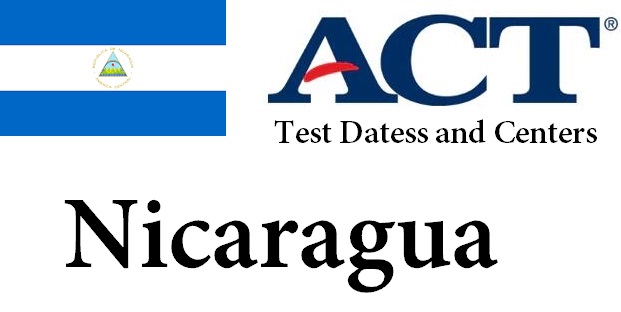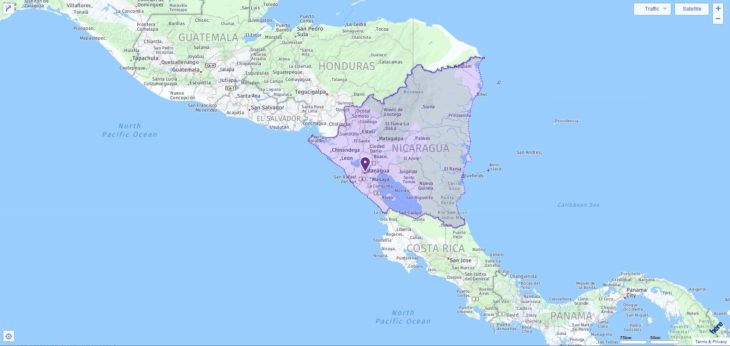Your search found 1 match. The following is the full list of ACT testing locations in Nicaragua among which you can pick one to take the exam. Please know that on the test day, test takers can use any 4-function, scientific, or graphing calculator. On the table below, you can also find all test dates through 2019.

2019-2020 ACT Test Dates in Nicaragua
| Test Date | Registration Deadline |
| February 9, 2019 | January 11, 2019 |
| April 13, 2019 | March 8, 2019 |
| June 8, 2019 | May 3, 2019 |
| July 13, 2019 | June 14, 2019 |
| September 14, 2019 | August 16, 2019 |
| October 26, 2019 | September 20, 2019 |
| December 14, 2019 | November 8, 2019 |
| February 8, 2020 | January 10, 2020 |
| April 4, 2020 | February 28, 2020 |
| June 13, 2020 | May 8, 2020 |
| July 18, 2020 | June 19, 2020 |
ACT Test Centers in Nicaragua
| City | Center Name | Center Code |
| Managua | American Nicaraguan School | 878000 |
More about Nicaragua
Politics
According to the constitution promulgated on 9 January 1987 (revised several times, most recently in 2014), Nicaragua is a presidential republic. The head of state, the chief executive officer (head of government) and the commander-in-chief of the armed and security forces is the president (with a vice-president as deputy), who is directly elected for a period of 5 years. He can be re-elected indefinitely. The President appoints the members of the Cabinet and has a right of veto over Parliament. The legislature lies with the National Assembly (Asamblea Nacional); 90 of the (currently) 92 MPs are elected by the people in the proportional representation system for 5 years, additional mandates are given to the replaced President (in the event of re-election, the replaced Vice-President) and the second-placed presidential candidate.
In 2006 Daniel Ortega came back to the highest office of the state after having been head of a Sandinista government from 1981-90. After three unsuccessful candidacies, he was elected on November 5. elected president. His Frente Sandinista de Liberación Nacional (FSLN) won the parliamentary elections and entered the parliament with 38 members. In order to further strengthen the influence of the FSLN, Ortega introduced citizens’ councils (“Consejos del Poder Ciudadano”, abbreviated to CPC) across the country. In terms of foreign policy, he intensified relations with the left-wing governments of Cuba and Venezuela. In 2009, the Supreme Court declared the constitutional articles prohibiting the re-election of the president at Ortega’s request not applicable and thus allowed him to run for a further term.
In 2011, Ortega prevailed again in an election overshadowed by irregularities. A constitutional revision passed by parliament in January 2014 enabled the president to be re-elected indefinitely. Before the parliamentary and presidential elections From the elections on November 6, 2016, he emerged as the clear winner with around 72.4% of the vote. The FSLN expanded its dominant position in parliament by winning 70 seats.
National symbols
The national flag was officially described for the first time on September 4, 1908. It consists of three identical horizontal stripes in the colors medium blue, white and medium blue. The national coat of arms is in the white stripe.
The coat of arms was established in 1908 and changed for the last time in 1971. In an equilateral light blue triangle, it shows a chain of five green volcanoes between two seas as an indication of the five provinces of the former Central American Federation. In the center of the triangle is a red Phrygian cap in a halo, which is spanned by a rainbow. The triangle is circumscribed in a circle with the official name of the state in the upper part and “America Central” in the lower arch.
The national holiday is September 15th. It commemorates the gaining of independence in 1821.
Parties
The most influential parties in the highly fragmented, unstable party system are the Frente Sandinista de Liberación Nacional (FSLN), the Partido Liberal Constitucionalista (PLC, founded in 1967), the Alianza Liberal Nicaragüense (ALN, founded in 2005) and the Movimiento Renovador Sandinista (MRS; founded in 1995).
Unions
In addition to the Sandinista dominated trade union federations, Central Sandinista de Trabajadores (CST), Asociación de Trabajadores del Campo (ATC) and Federación de Trabajadores de Salud (FETSALUD), bourgeois unions also gained influence after 1990, e. B. Central de Trabajadores de Nicaragua (CTN) and Confederación de Unificación Sindical (CUS). The umbrella organization of the Sandinista trade union federations is the Frente Nacional de los Trabajadores.
Military
The total strength of the volunteer army is about 12,000 men. The army (around 10,000 soldiers) has a light mechanized brigade, two independent infantry battalions, a command regiment, a special forces brigade, a transport regiment and an engineer battalion; In addition, there are six regional commandos, each with battalion strength. The air force has 1,200 and the navy around 800 men.
Administration
Nicaragua is divided into 15 departments and 2 autonomous regions.
Administrative division in Nicaragua
| Administrative division (2016) | |||||
| Administrative unit | Area (in km 2) | Population (in 1,000) | Residents (per km 2) | Administrative headquarters | |
| Department | |||||
| Boaco | 4 177 | 179.9 | 43 | Boaco | |
| Carazo | 1 081 | 192.1 | 178 | Jinotepe | |
| Chinandega | 4 822 | 431.7 | 90 | Chinandega | |
| Chontales | 6 481 | 186.9 | 29 | Juigalpa | |
| Estelí | 2 230 | 225.4 | 101 | Estelí | |
| Granada | 1 040 | 207.7 | 200 | Granada | |
| Jinotega | 9 222 | 445.6 | 48 | Jinotega | |
| Leon | 5 138 | 412.9 | 80 | Leon | |
| Madriz | 1 708 | 166.2 | 97 | Somoto | |
| Managua | 3,465 | 1,496.7 | 432 | Managua | |
| Masaya | 611 | 369.6 | 605 | Masaya | |
| Matagalpa | 6 804 | 567.7 | 83 | Matagalpa | |
| Nueva Segovia | 3,491 | 257.0 | 74 | Ocotal | |
| Rio San Juan | 7 543 | 128.8 | 17th | San Carlos | |
| Rivas | 2 162 | 178.7 | 83 | Rivas | |
| Autonomous Region | |||||
| North Caribbean coast | 33 106 | 490.4 | 15th | Puerto Cabezas | |
| Caribbean coast south | 27 260 | 390.7 | 14th | Bluefields | |
Law
At the top of the judiciary is the Supreme Court (Corte Suprema de Justicia) with a chamber each for civil, criminal, administrative and constitutional matters. Its 16 judges are elected by the National Assembly for 7 years. Subordinate to appellate, district and local courts, there are also military courts. – The civil code of 1904 shows continental European and Latin American influences, as does the commercial code of 1917. The penal code is from 1974.

